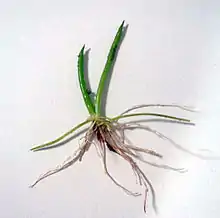Littorella uniflora
Littorella uniflora (vernacular name: (American) shoreweed) is a species of aquatic flowering plant native to the Azores, Morocco, most of Europe excluding the dry southeast, Iceland, and the Faroes.[2] It prefers to live mostly submerged in nutrient-poor freshwater habitats. When submerged, it draws CO2 mostly through its roots and uses a mix of crassulacean acid metabolism (CAM) and C3 carbon fixation for photosynthesis. If the water level drops and exposes the roots, it ceases using CAM.[3]
| Littorella uniflora | |
|---|---|
 | |
| Scientific classification | |
| Kingdom: | Plantae |
| Clade: | Tracheophytes |
| Clade: | Angiosperms |
| Clade: | Eudicots |
| Clade: | Asterids |
| Order: | Lamiales |
| Family: | Plantaginaceae |
| Genus: | Littorella |
| Species: | L. uniflora |
| Binomial name | |
| Littorella uniflora | |
| Synonyms[2] | |
| |
References
- Fl. Brandenburg 1: 544 (1864)
- "Littorella uniflora (L.) Asch". Plants of the World Online. Board of Trustees of the Royal Botanic Gardens, Kew. 2017. Retrieved 2 December 2020.
- Robe, W. E.; Griffiths, H. (2000). "Physiological and photosynthetic plasticity in the amphibious, freshwater plant, Littorella uniflora, during the transition from aquatic to dry terrestrial environments". Plant, Cell & Environment. 23 (10): 1041–1054. doi:10.1046/j.1365-3040.2000.00615.x.
This article is issued from Wikipedia. The text is licensed under Creative Commons - Attribution - Sharealike. Additional terms may apply for the media files.